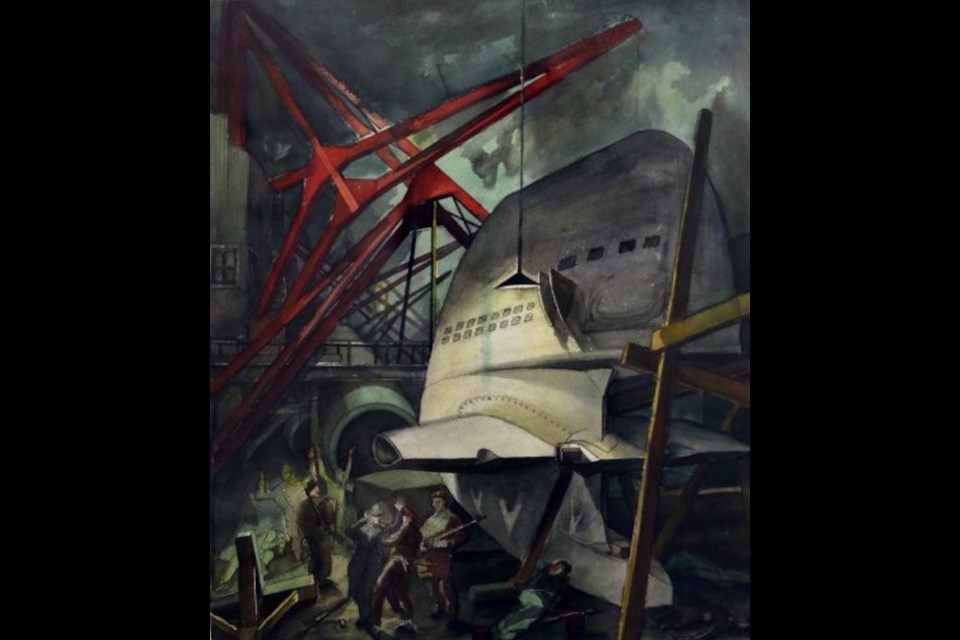 Victorians love watercolours. We are fascinated by local history. And we want to know what is being preserved for us in the Art Gallery of Greater Victoria’s collection. As one of six shows currently at the gallery that are drawn from the permanent collection, Water+Pigment+Paper, is doing everything right.
Victorians love watercolours. We are fascinated by local history. And we want to know what is being preserved for us in the Art Gallery of Greater Victoria’s collection. As one of six shows currently at the gallery that are drawn from the permanent collection, Water+Pigment+Paper, is doing everything right.
Michelle Jacques, chief curator of the Art Gallery of Greater Victoria, and co-curator Nicole Stanbridge, present their two largest rooms richly hung with dozens of treasures from the vaults, many of them previously unseen.
Watercolour is the first painting medium given to children, but it is known as the most difficult technique. Because one paints with transparent washes of colour, the untouched white paper must be preserved as the lightest tone.
Thus, a successful watercolour usually begins with a perfect drawing, and every brushstroke makes the painting darker. You have to know where you are going.
While pigments mixed with water — and a bit of glue — have been used since time immemorial, the English manner of transparent tinted washes began with the military. Scouts achieved more sense of depth in their reconnaissance drawings of the landscape by adding a warm and a cool tone.
Watercolour was taught in British military colleges and, when the officers returned home after the Napoleonic Wars, they travelled throughout Britain and taught gentlewomen painting, as a pastime. These sketchers looked carefully at the British landscape, and the English watercolour tradition was born.
An outstanding atmospheric watercolour by Samuel Palmer (1805-1881), painted high among peaks in the Welsh Mountains is strongly reminiscent of the work of J.M.W. Turner.
The industrial revolution brought machines with which to grind pigments and collapsible metal tubes to store them in. Thus, artists could make paintings without having first to make their paints. The developing chemistry of coal tar derivatives yielded new, brighter colours — mauve was the first.
Phoebe Anna Traquair (1852-1936) is well represented, and her jewel-like pre-Raphaelite studies in Victoria’s collection are seen, for perhaps the first time, in this show.
Canadian history was recorded in watercolour, first with British military in New France. The Gold Rush on the Fraser River in 1858 inspired sketchbooks full of watercolours. With the building of the Canadian Pacific Railway, artists were offered free passes to paint the West. Lucius O’Brien (1832-1899), founding president of the Royal Canadian Academy, was the first, in 1885.
In Victoria, educated British womenfolk picnicked and painted watercolours of the beautiful landscape. Sarah Crease and her daughters Susan and Josephine, were active in the founding of the Island Arts and Crafts Society in 1901.
This exhibit takes particular note of Victoria’s women artists, including Sophie Pemberton, Margaret Kitto, Maude Lettice and Ina Uhthoff.
Women artists predominantly painted in watercolour, one reason that they have been historically under-represented in our galleries. Aside from sexism, these typically small-scale paintings don’t show well in big, modern galleries, and their protective glazing adds glare to the image. It is for these reasons that the gallery’s Art Rental program no longer accepts watercolours. Yet, because they are easy to store (without frames) and have more documentary than decorative value, watercolours make up a large percentage of the gallery’s collection.
Early Canadian moderns — Florence McGillivray, Emily Carr and Grace Melvin, for example — used water-based media to execute larger pictures, delighting in the freedom that came with the relatively inexpensive materials, convenient to use in the field. Among the Group of Seven, Franklin Carmichael was the leading watercolourist, while Fred Varley and his girlfriend Vera Weatherbie favoured watercolour for their intimate creations. Beyond the group, artist David Milne conducted a life-long conversation in watercolour. The AGGV is particularly rich in his work.
Toward the mid-century, painters found the instantaneous brushwork of watercolour captured their feelings. A feature wall is given over to three large paintings by Pegi Nicol (1904-1949), a short-lived star from eastern Canada.
Two fine full-sheet paintings from 1946 and 1951 by Jack Shadbolt (1909-1998) show the medium at its free-swinging best.
This show makes a point of telling our local story. Herbert Siebner received a travel grant in 1962 and sent dozens of paintings to be published in the Victoria Daily Times. Twelve of these are on show. A large portrait of sculptor Elza Mayhew by Myfanwy Pavelic conveys an explicit likeness with loose gesture.
The gallery’s Chinese paintings, an extensive and outstanding collection, are almost all ink and watercolours.
Representing this wealth is a painting of a butterfly by Hua Yan (1682-1765) in the “boneless” style, and a late-20th century scene of a city by night by Wu Guanzhong (born 1919). Seattle’s Mark Tobey and our own Jack Wise were inspired by the calligraphic marks of the Chinese approach and are represented, though admittedly not at their best.
Max Bates (1906-1980), Canada’s foremost expressionist artist, drew with pen and ink on his wet watercolours, resulting in unexpected effects. Michael Morris (born 1942), Bates’ protégé, is best known for his hard-edged paintings in gouache, a form of watercolour made opaque by the addition of white pigment. His large figure study of a boy, nude, plays with broad pools of transparent colour.
The gallery has enough watercolours to put on a show like this many times over. Watercolours by Paul Signac, Ben Nicholson and Lyonel Feininger are still waiting in the basement for their turn. But for now, I salute the curators for giving the public what they want. Buy a membership — repeated visits to the gallery are necessary.
Water+Pigment+Paper: Experiments in Watercolour from the AGGV Collection (Art Gallery of Greater Victoria, 1040 Moss St., 250-384-4171, aggv.ca) until May 23.



